
The last old news story to catch up on is a major one: Éditions Dupuis announced on 26 March that they had purchased the Marsu Productions publishing house. The acquisition means that a number of their former titles and characters are returning to Dupuis, most notably Gaston Lagaffe, Marsupilami and Natacha. In particular, it means that after more than 40 years, the Marsupilami can now again appear in Spirou, which subsequent reports confirm will happen in Yoann & Vehlmann’s album #55, expected in 2014.
Unusually for a European comic, Spirou belongs to the publisher, Dupuis. From 1946 to 1968, it was written and illustrated by André Franquin (with the help of numerous collaborators and assistants), who created an entire universe for the series. Under the terms of the deal struck when he left the title, all the supporting characters and other elements he contributed (from Champignac to Zorglub) would belong to Dupuis, except only for the Marsupilami. He also retained the rights to original series set in the same universe, such as Gaston and Le Petit Noël:
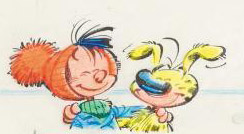
None of these characters disappeared from the magazine: Franquin continued to make comics with each of them, with new Gaston gags weekly, and Marsupilami gags and Noël stories more irregularly. However, since they were his, other authors or artists couldn’t use them, and that effectively meant they had to be gone from the Spirou series. Gaston and Noël were quite peripheral characters, so that wasn’t a problem, but the Marsupilami had been an integral and popular part of the comic, and it vanished inexplicably after a final appearance (drawn by Franquin) in Fournier’s first adventure, Le faiseur d’or (“The Gold Maker,” Spirou 20). Some fans still haven’t gotten over it.
Then in 1986, Franquin sold the rights to the Marsupilami to his friend Jean-François Moyersoen, a millionaire diamond dealer and comics fan. Moyersoen set up a new publishing company (based in Monaco for tax purposes): Marsu Productions. Franquin worked with Yann and Batem to create a Marsupilami album series for Marsu, which was a great sales success and is still running, some 26 albums later. Marsu later also acquired the rights to Gaston and the rest of Franquin’s work.
Although the company also owns the rights to Walthéry’s Natacha and a number of other series, Marsu’s most significant and lucrative intellectual property has always been the Franquin comics. It has done many fine things with the license, such as a complete chronological album edition of Gaston, a number of attractive art books of Franquin’s illustrations, and deluxe album editions reproducing Franquin’s original ink pages (with all the pencil marks, annotations and corrections visible) in full size. At the same time, a number of projects seem like dubious cash-ins, such as licensing the Marsupilami to Disney for a bastardized cartoon series, repackaging the same material over and over again in different combinations, editing Spirou and Fantasio out of Le nid des Marsupilamis (“The Nest of the Marsupilamis,” Spirou 12) so that they could release their own version of the album, and most recently creating “kid versions” of their two most popular series with Marsu Kids and Gastoon.
Marsu Productions have also been very aggressive in asserting their rights to the Marsupilami and to Franquin, whose name they trademarked after his death. They shut down the parody comic Le blog de Franquin. They refused permission for Munuera to use the Marsupilami in the time-travel story Aux sources de Z (“The Origins of Z,” Spirou 50), in a panel based on one by Franquin:
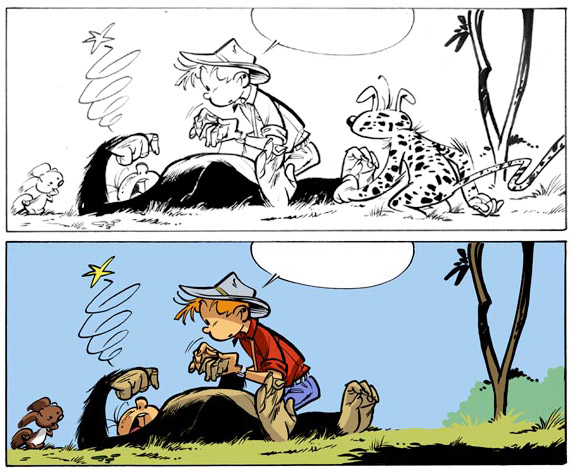
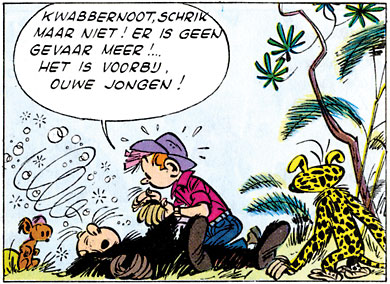
They have also blocked the republication of the Spirou and Gaston story Les Robinsons du rail (“The Railway Robinsons”) for nearly two years, presumably in dispute with Dupuis over who holds the rights. Perhaps most egregiously, they demanded that Dupuis edit the Marsupilami out of the cover for volume 6 of the collected Spirou, modifying Franquin’s drawing:
Bringing the rights together should simplify the situation and eliminate this kind of conflict. At the same time, further consolidation in Franco-Belgian comics publishing brings Média-Participations (which owns Dupuis, Dargaud, Le Lombard and many others) even closer to a monopoly position.

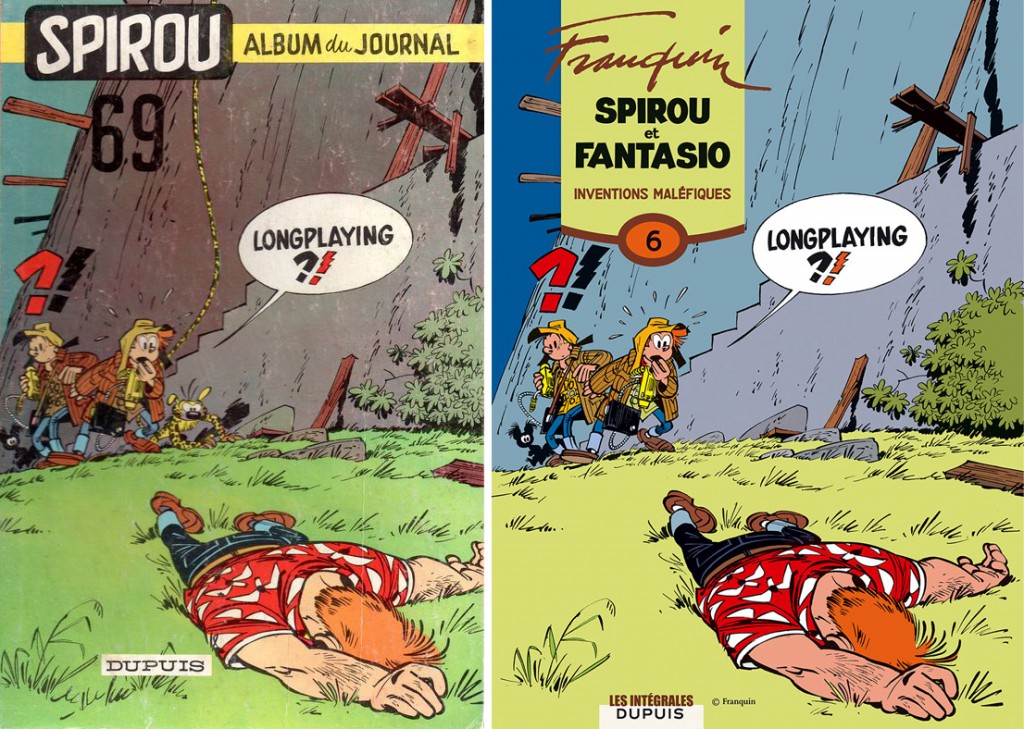
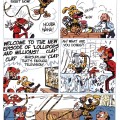


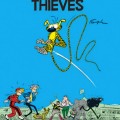



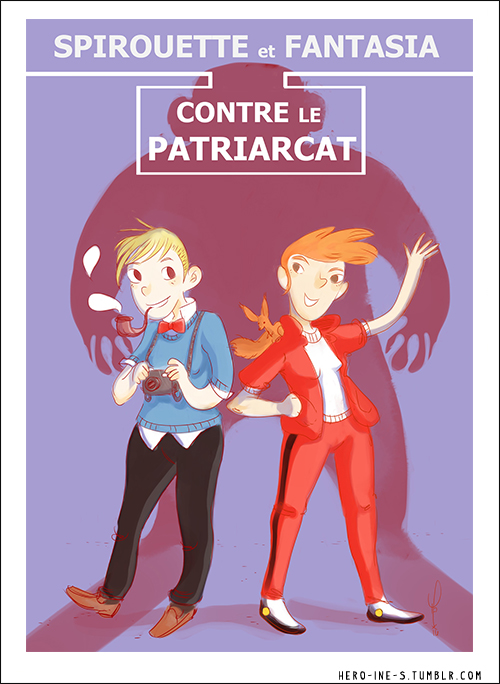
You write that Spirou and Marsipulami will be reunited in Yoann & Vehlmann’s album 55. Actually, they have already been reunited in a short story by Fabrice Tarrin in the anniversary edition of Journal de Spirou.
Yes I know, I posted about it [url=https://spiroureporter.net/2013/04/17/anniversary-issue-samples/]here[/url]. But it’s not an “official” story, so it doesn’t count. It’s certainly not “in continuity”; something future stories will use as a starting point. Yoann and Vehlmann are the official Spirou team, and they’ll reintroduce the Marsupilami to the series proper in album 55.
Odd Eivind Koppang Torp liked this on Facebook.
Not sure what you mean with “official”. Are not the one shots “official”? Fabrice Tarrin made a one-shot longer story together with Yann. And I am not sure if all stories published in the main Spirou series will be taken into consideration when making future Spirou stories. Should for instance Aux sources du Z be considered when making future histories? Here one ended up with a Spirou which was much younger than Fantasio and who had no memory of their previous adventures together. Not to mention Machine qui rêve, the last story by Tome and Janry, which in fact was much more deviant from the main story than Le tombeau des Champignac by Yann and Tarrin. Maybe a solution would be for Yoann to repaint the story by Tarrin and include it into Spirou 55 as part of a longer story?
The simple answer is that the official stories are the album adventures in the main series. Currently, anything added that isn’t by Yoann & Vehlmann is not official.
The one-shots are just that: out-of-continuity standalone stories (what American comics often call “What Ifs” or “Imaginary Stories,” and Don Rosa has termed “fictional fiction”). They’re official but separate: they aren’t part of and don’t affect the main series.
Spirou 46 ([i]Machine qui rêve[/i]) and 50 ([i]Aux sources du Z[/i]) are official adventures, although Yoann & Vehlmann have made clear that further time travel undid the outcome of the latter “off-screen.”
I’d say there’s no chance whatsoever that Yoann would redraw Tarrin’s short, and I don’t think either of them would want that to happen. It was always meant as an unofficial, standalone joke story, and I think if you could read it you’d see that it doesn’t really make sense as part of the official series. Vehlmann is going to write his own version of the reunion, and explain why the Marsupilami has been missing, and that will be the official story.
I believe “Aux sources du Z” originally was meant as an out-of-continuity tribute one-shot, until Dupuis decided to fit it into the original canon.
Apropos “Aux sources du Z”, it’d be cool if Marsupilami was reinserted for possible reprints of the album. The panel layout would look more harmonious.